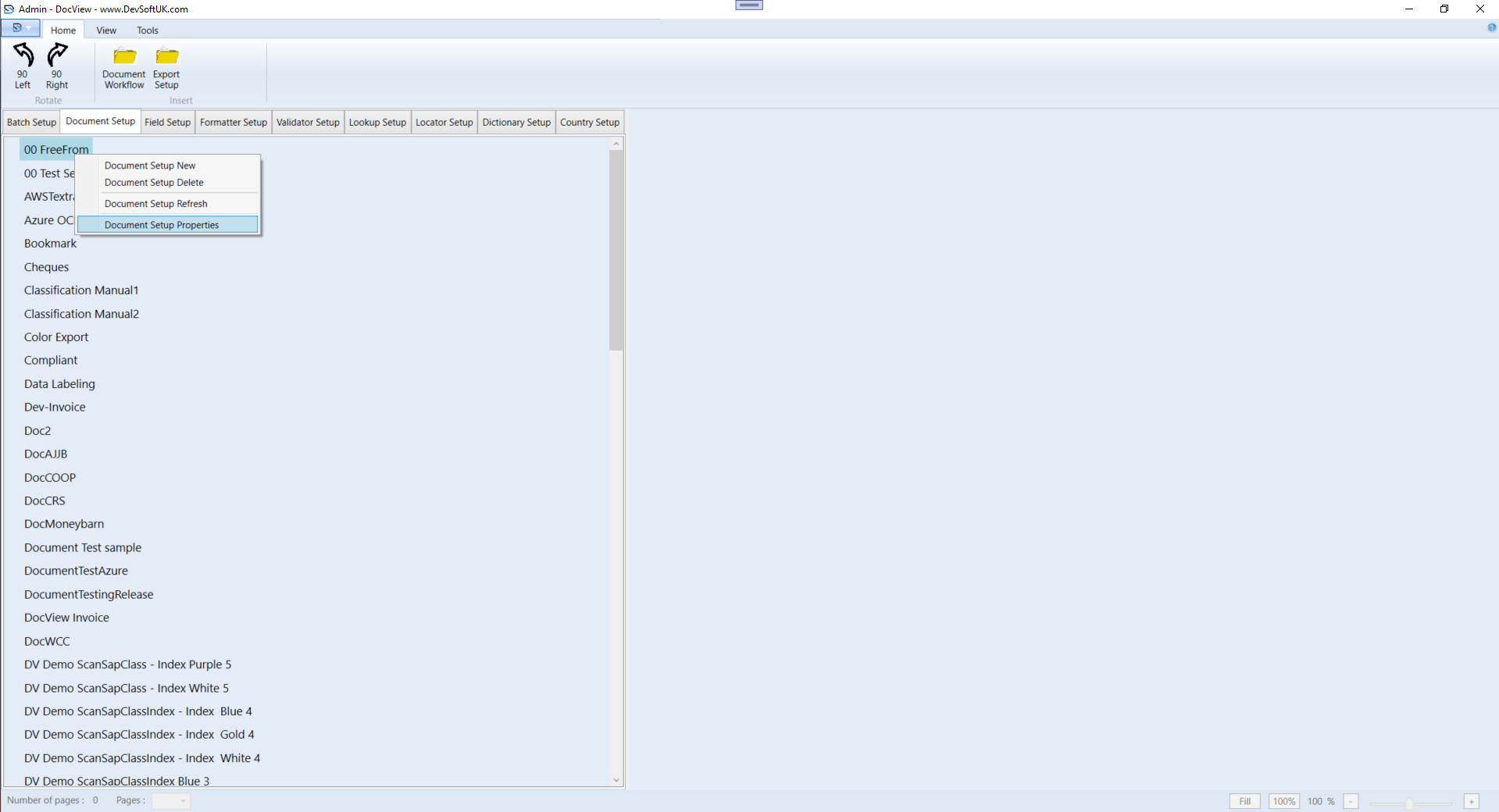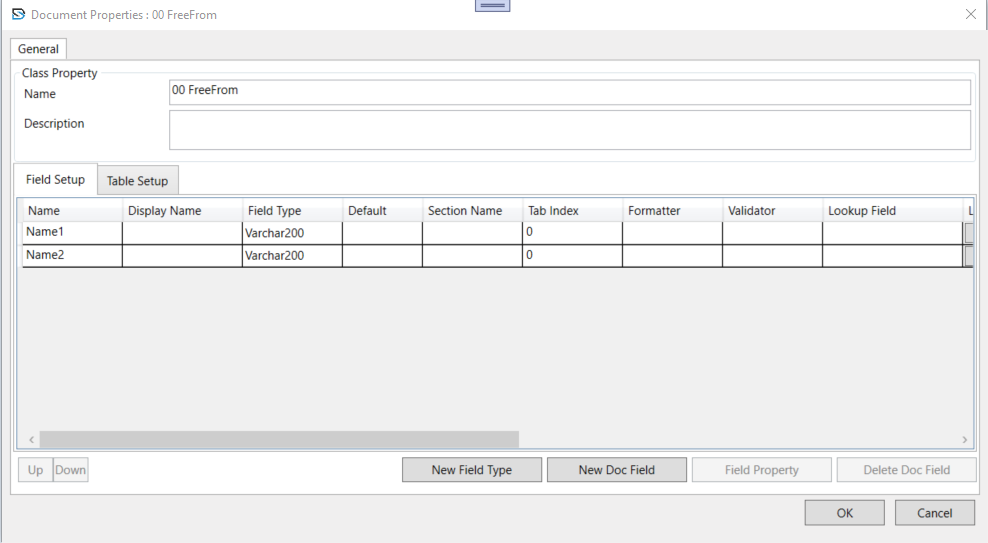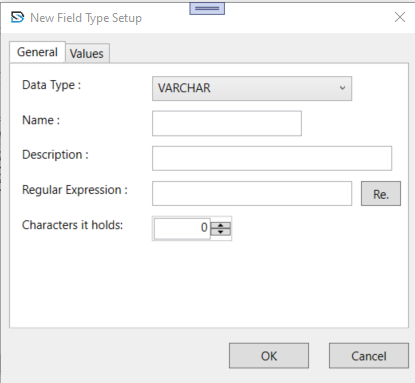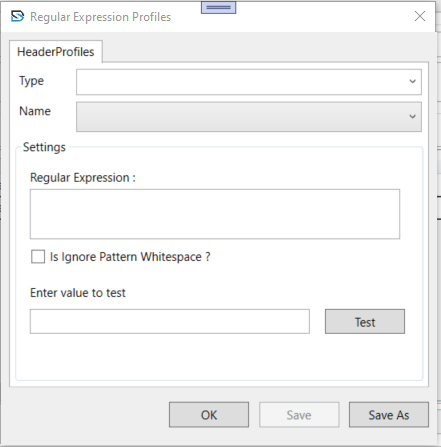Document Setup Properties



Document setup name
DescriptionThis description is for informational use only and appears whenever the batch properties are viewed.
Setup TypeField Setup
Table Setup
Document Setup Details1. Field Setup
To define Document fields, click the 'New Field Type' button and enter the required details in the Document Fields table:
NameBy default, batch field names are generated as Nameₙ (where n is a number starting from 0). You can rename the field as needed.
Display Name
For each batch or index field, you can specify a Display Name. This name is shown in place of the actual field name across modules such as Scan, Validation, Verification, and Batch
Manager.
For example, if a field is named 00 Test Setup, you can set the Display Name to Customer Name so users see a more readable label. This is especially useful when localizing a batch class
for different regions—Display Names can be entered in the appropriate language.
If no Display Name is provided, the original field name will be displayed by default.
Field TypeSelect a Field Type for your batch field. All previously defined field types are available in the drop-down list. To create a new field type, click the New Field Type button.
DefaultEnter or select a default value for the batch field. You can either type a value or choose from the drop-down list of available DocView Capture values.
Note: Required and Hidden cannot both be set to True—enabling one will automatically disable the other.
Section NameSpecifies a grouping or logical section for the field.
Fields with the same section name may be displayed together in UI modules like Scan, Validation, or Verification. Useful for organizing fields on multi-tab forms.
Tab IndexControls the tab order when navigating through fields during data entry.
A lower number means earlier focus when pressing the Tab key. Helps streamline keyboard navigation.
FormatterApplies formatting rules to field values, such as date, currency, or custom string formats.
Formatters ensure data is displayed and stored in a consistent and readable format.
ValidatorDefines a validation rule (e.g., regex, value range) that checks user input or OCR results.
If the data does not meet the validation criteria, a warning or error is shown to the user.
Lookup FieldSpecifies whether the field value should be auto-filled using a lookup table.
The actual lookup logic is configured via the Lookup Setup button.
Lookup SetupOpens a configuration dialog to set up lookup rules using external sources like CSV files, databases, or predefined lists.
It maps field values based on matching keys or references.
RequiredIf checked, the field must be filled in before proceeding.
The system will prevent moving forward (e.g., during scanning or validation) if the field is left empty.
VerifyMarks the field for manual verification.
Even if auto-extracted via OCR, the user will be prompted to verify its value during the Verification step.
HiddenWhen enabled, the field is hidden from the user interface across modules (Scan, Validation, etc.).
Hidden fields are still captured and exported but not shown to users.
Note: A field cannot be both Required and Hidden at the same time.
StickyIf enabled, the last entered value for this field will automatically populate in the next document.
Useful when the same value is reused frequently.
ReadOnlyMakes the field uneditable in the UI.
Useful when the same value is reused frequently.Useful when the value comes from OCR, barcode, or lookup and must not be changed by users.
LocatorAssigns a predefined locator rule to the field, which determines how and where the field is extracted from the document image using zones or patterns.
Min ConfidenceThe minimum OCR confidence (e.g., 10) required for the field value to be accepted without flagging.
Lower confidence values may be ignored or sent for manual check.
Min Confidence ValidThe minimum confidence level (e.g., 80) needed to auto-validate the field without user review.
If confidence is lower, the field is flagged for verification.
Min DistanceUsed to determine the accuracy of field extraction zones.
It defines how close the detected value must be to the expected zone or anchor region. Larger distances increase the chance of extraction mismatches.



2. Table Setup
Used to configure table-type data fields (i.e., fields with multiple rows and columns) associated with the document.
Table Name:The internal name of the table field (e.g., TableName1).
Display Name:Optional user-friendly label shown in the UI.
Tab Index:Defines the tab order for UI navigation.
Table Type:Indicates the field type; here it is Table_Field.
Column Setup:Contains a Setup button to configure the columns of the selected table.
New Field Type ButtonThis window allows you to define a custom field type for your document. It has two tabs: General and Values
1. General Tab Fields:Data Type:
Select the type of data this field will hold (e.g., VARCHAR, EMAIL, DOUBLE, INTEGER, DATETIME, TABLE etc.).
Name:Enter a unique internal name for this field type.
Description:Optionally provide a brief description for easy reference.
Regular Expression:Set a pattern to validate the data input (e.g., email, numbers). Click the “Re.” button to assist with setting the regular expression.
1.1 Regular Expression ProfilesThis window helps you create, test, and manage regular expressions to validate the field's data format.
Tabs:HeaderProfiles: Default tab for managing regular expression profiles.
Fields & Options:Type:
Dropdown to select the data type this regex applies to (e.g., header field, footer field, etc.).
Name:Select or enter a name for your regex profile to save or reuse it later.
Regular Expression:Input the pattern you want to use to validate field data (e.g., \d{5}, [A-Z]{3}-\d{4}, etc.).
Is Ignore Pattern Whitespace?:Checkbox to ignore whitespace in the regex pattern (useful for readability).
Enter value to test:Field to enter a sample value you want to validate against the regex.
Test:Button to instantly check if the sample value matches the regex.
Bottom Buttons:OK: Save and apply the selected regex profile and close the window.
Save: Save the regex profile for future use.
Save As: Save it under a new name as a new profile.
Characters it holds:Specify the maximum number of characters this field can contain (applies mostly to VARCHAR).
New Doc Field ButtonAdds a new document field (or batch field) to the Field Setup or Table Setup grid.
By default, it is named like Nameₙ (e.g., Name1, Name2) and uses the default field type. You can then customize its attributes (e.g., Display Name, Field Type, Formatter, etc.).
Find Property ButtonOpens the Field Property window for the selected document field.
Field behavior across modules
Associated formatter/validator rules
Positioning or layout options: Use this for more granular control beyond what’s available directly in the table.
Delete Doc Field ButtonRemoves the selected document field from the setup table.
This action permanently deletes the field from the current document setup (it won’t affect fields used in other setups).
💡 You can also delete a field by right-clicking on it and selecting Delete, or by pressing the Delete key on your keyboard.
